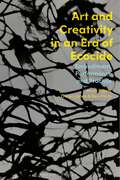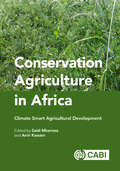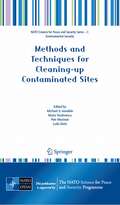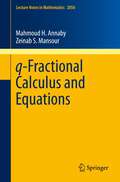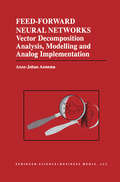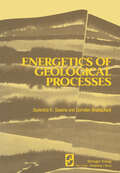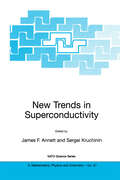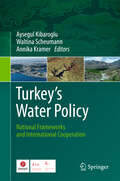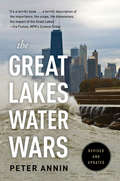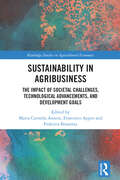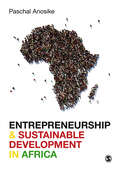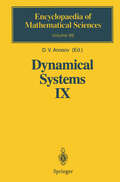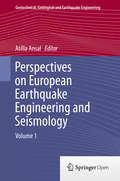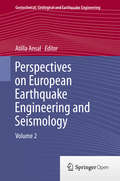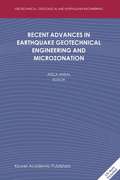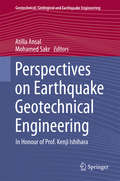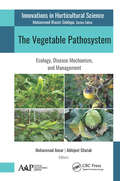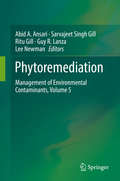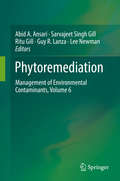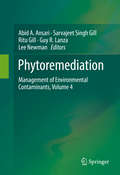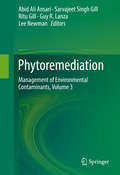- Table View
- List View
Art and Creativity in an Era of Ecocide: Embodiment, Performance and Practice
by Anna Pigott, Owain Jones and Ben ParryWhat can creativity achieve in an era of ecocide? How are people using creative and artistic practices to engage with (and resist) the destruction of life on earth? What are the relationships between creativity and repair in the face of escalating global environmental crises? Across twelve compelling case studies, this book charts the emergence of diverse forms of artistic practice and brings together accounts of how artists, scholars and activists are creatively responding to environmental destruction.Highlighting alternative approaches to creativity in both conventional art settings and daily life, the book demonstrates the major influence that ecological thought has had on contemporary creative practices. These are often more concerned with subtle processes of feeling, experience and embodiment than they are with charismatic 'eco-art' works. In doing so, this exploratory book develops a conception of creativity as an anti-ecocide endeavour, and provides timely theoretical and practical insights on art in an age of environmental destruction.
Conservation Agriculture in Africa: Climate Smart Agricultural Development
by Mohamed Annabi Haithem Bahri Mloza Banda Gotlieb Basch Richard Bell Alexandra Bot Trent W Bunderson Martin Bwalya Hatem Cheikh M’hamed Cornelius Chiduza Cary Clark Demba Diakhaté Mazwi Dlamini Sjoerd Duiker Alioune Fall Aymen Frija Patrick Gicheru Josiah Gitari Tom Goddard Emilio Gonzalez-Sanchez Isaac Gura Enamul Haque Michel Havard Zied Idoudi Mohammad Jahiruddin Zwide D Jere Josef Kienzle Onesmos Kitonyo Erna Kruger Peter Kuria Phlorentin Philip Lagwen Simon Lugandu Ngari Macharia Temakholo Mathebula Sixolise Mcinga Alfred Micheni Neil Miller Frank Mmbando Rachid Moussadek Pearson Nyari Mnkeni Rachid Mrabet Ndabhemeye Mulengera Walter Mupangwa Joseph Mureithi R. M. Museka Weldone Mutai Munyaradzi Mutenje Lindah Muzangwa Remmy Mwakimbwala Andre A Nel James Njeru Rama Ngatoluwa Phumzile Ngcobo Isaiah Nyagumbo Putso Nyathi Ricardo Ralisch Leonard Rusinamhodzi John Sariah Ibrahima Sarr Peter Setimela Richard Shetto Reynolds K. Shula Brian G. Sims Hendrik J. Smith Dimas Soares Júnior Peter Steward Johann Strauss Christian Thierfelder Gerhardus Trytsman Jean Twilingiyumukiza Carl Wahl Peter Waweru Nouhoun ZampaligreTillage agriculture has led to widespread soil and ecosystem degradation globally, and more particularly in the developing regions. This is especially so in Africa where traditional agricultural practices have become unsustainable due to severe exploitation of natural resources with negative impacts on the environment and food system. In addition, agricultural land use in Africa today faces major challenges including increased costs, climate change and a need to transform to more sustainable production intensification systems. Conservation Agriculture has emerged as a major alternative sustainable climate smart agriculture approach in Africa and has spread to many African countries in the past decade as more development and research, including in sustainable mechanization, has enabled its extension and uptake. It is key to transforming Africa's agriculture and food system given its ability to restore soil health, biodiversity and productivity of millions of smallholder farms as well as larger-scale farms. This landmark volume is based on the material presented at the Second Africa Congress on Conservation Agriculture which was held in Johannesburg, South Africa, 9-12 October 2018. The main theme of the Congress was 'Making Climate Smart Agriculture Real in Africa with Conservation Agriculture: Supporting the Malabo Declaration and Agenda 2063'. The Congress was aligned to mobilize stakeholders in all agriculture sectors to provide greater technical, institutional, development and investment support, impetus and direction to the vision and agenda for transforming African agriculture as set out by the Malabo Declaration and Agenda 2063. This book is aimed at all agricultural stakeholders in the public, private and civil sectors in Africa engaged in supporting the transformation of conventional tillage agriculture to Conservation Agriculture. The book will be of interest to: researchers, academics, students, development stakeholders, public and private sector investors and policy makers as well as institutional libraries across the world.
Methods and Techniques for Cleaning-up Contaminated Sites (NATO Science for Peace and Security Series C: Environmental Security)
by Michael D. Annable Maria Teodorescu Petr Hlavinek Ludo DielsThis publication comprises the presentations made at the NATO Advanced Research Workshop held in Sinaia, Romania 9 – 11 October, 2006. The contributions represent a unique cross section of issues and challenges related to contaminated site management. These range from low cost solutions to petroleum contaminated sites to advances in biological treatment methods. The publication is meant to foster links between groups facing challenges cleaning up contaminated sites.
q-Fractional Calculus and Equations (Lecture Notes in Mathematics #2056)
by Mahmoud H. Annaby Zeinab S. MansourThis nine-chapter monograph introduces a rigorous investigation of q-difference operators in standard and fractional settings. It starts with elementary calculus of q-differences and integration of Jackson’s type before turning to q-difference equations. The existence and uniqueness theorems are derived using successive approximations, leading to systems of equations with retarded arguments. Regular q-Sturm–Liouville theory is also introduced; Green’s function is constructed and the eigenfunction expansion theorem is given. The monograph also discusses some integral equations of Volterra and Abel type, as introductory material for the study of fractional q-calculi. Hence fractional q-calculi of the types Riemann–Liouville; Grünwald–Letnikov; Caputo; Erdélyi–Kober and Weyl are defined analytically. Fractional q-Leibniz rules with applications in q-series are also obtained with rigorous proofs of the formal results of Al-Salam-Verma, which remained unproved for decades. In working towards the investigation of q-fractional difference equations; families of q-Mittag-Leffler functions are defined and their properties are investigated, especially the q-Mellin–Barnes integral and Hankel contour integral representation of the q-Mittag-Leffler functions under consideration, the distribution, asymptotic and reality of their zeros, establishing q-counterparts of Wiman’s results. Fractional q-difference equations are studied; existence and uniqueness theorems are given and classes of Cauchy-type problems are completely solved in terms of families of q-Mittag-Leffler functions. Among many q-analogs of classical results and concepts, q-Laplace, q-Mellin and q2-Fourier transforms are studied and their applications are investigated.
Feed-Forward Neural Networks: Vector Decomposition Analysis, Modelling and Analog Implementation (The Springer International Series in Engineering and Computer Science #314)
by Jouke AnnemaFeed-Forward Neural Networks: Vector Decomposition Analysis, Modelling and Analog Implementation presents a novel method for the mathematical analysis of neural networks that learn according to the back-propagation algorithm. The book also discusses some other recent alternative algorithms for hardware implemented perception-like neural networks. The method permits a simple analysis of the learning behaviour of neural networks, allowing specifications for their building blocks to be readily obtained. Starting with the derivation of a specification and ending with its hardware implementation, analog hard-wired, feed-forward neural networks with on-chip back-propagation learning are designed in their entirety. On-chip learning is necessary in circumstances where fixed weight configurations cannot be used. It is also useful for the elimination of most mis-matches and parameter tolerances that occur in hard-wired neural network chips. Fully analog neural networks have several advantages over other implementations: low chip area, low power consumption, and high speed operation. Feed-Forward Neural Networks is an excellent source of reference and may be used as a text for advanced courses.
Energetics of Geological Processes: Hans Ramberg on his 60th birthday
by H. Annersten O. StephanssonHans Ramberg is working in an area of geology where 60 years are a short, often negligible period of time. This is not so in the lives of men. For us it is a time for evaluating past accomplishments and a time for friends to express their appreciation and admiration. Some universities have become famous for this ability to foster eminent scientists in one or several fields. The success of Cambridge University in physics is a well-known example, but if we ask ourselves whether the success of Oslo University in earth sciences is not equally astonishing, then we see that Hans is yet another example of this process; but it is not the whole story. There were certainly promising prospects when he started his studies in geology: V. M. Goldschmidt had just come back from G6ttingen in Germany and Tom Barth had returned from the Geophysical Laboratory in Washington, D.C. Two leaders in geochemistry and petrology at the same time! Hans became a student of Barth, specializing in metamorphic rocks and their problems; but soon the situation changed. Norway was occupied by the Germans and the possibili ties for university studies almost vanished. However, in spite of all difficulties he obtained his Ph.D. in 1946 and began participating in the geological mapping of Greenland. In 1947 he went to the University of Chicago and stayed there until 1961 when he came to his present position in the University of Uppsala, Sweden.
New Trends in Superconductivity (NATO Science Series II: Mathematics, Physics and Chemistry #67)
by James F. Annett Sergei KruchininProceedings of the NATO Advanced Research Workshop, Yalta, Ukraine, from 16-20 september 2001
Turkey's Water Policy: National Frameworks and International Cooperation
by Annika Kramer, Aysegul Kibaroglu and Waltina ScheumannWater is a strategic natural resource of vital importance to all nations. As such it has been the cause of several international disputes. For Turkey especially, water is crucial to social and economic development. Turkey’s current national water regime that emphasises water resources development and management for productive uses, however, faces growing environmental concerns and international criticism regarding transboundary water cooperation. Furthermore, EU accession requires Turkey to adopt an extensive and ambitious body of EU water law. To understand Turkey’s position to international water law, the national policies and socio-economic circumstances that impact water resources management need to be considered. This book fills the existing knowledge gap through a broad perspective and analysis of the current state of Turkey’s water policy and its management of both national and transboundary waters. It is a unique undertaking that brings together Turkish and international authors, practitioners and academics, covering all aspects of water management
The Great Lakes Water Wars
by Peter AnninThe Great Lakes are the largest system of freshwater lakes in the world and America’s greatest freshwater resource. For over a century they have been the target of controversial diversion schemes designed to sell, send, or ship water to thirsty communities, sometimes far from the source. In part to protect the Great Lakes from overzealous entrepreneurship, the Great Lakes Compact was signed in 2008. Although the Compact fulfills that promise and ensures that Great Lakes water stays within the Basin, some would say it has only shifted the controversy closer to home. Now water diversion controversies of a different kind are some of the most fought-over environmental issues in the region. Will the water wars ever be settled?Journalist Peter Annin delves deeply into the fraught history of water use in the Great Lakes region and recaps the story of the Chicago River diversion, which reversed the flow of the river, fundamentally transforming the Great Lakes ecosystem. A century later it remains “the poster child of bad behavior in the Great Lakes.” Today, with growing communities and a warming climate, tensions over water use are high, and controversies on the perimeter of the Great Lakes Basin are on the rise. In this new and expanded edition of The Great Lakes Water Wars, Annin shares the stories of New Berlin and Waukesha, two Wisconsin communities straddling the Basin boundary whose recent legal battles have tested the legislative strength of the newly signed Compact. Annin devotes a new chapter to the volatile issue of the invasive Asian carp—a voracious species that reproduces at a disturbing rate—which is transforming the ecology of the river as it makes its way through the Chicago River diversion and ever closer to Lake Michigan.With three new chapters and significant revisions to existing chapters that bring the story up-to-date over the past decade, this is the definitive behind-the-scenes account of the people and stories behind hard-fought battles to protect this precious resource that makes the region so special for the millions who call it home.
Sustainability in Agribusiness: The Impact of Societal Challenges, Technological Advancements, and Development Goals (Routledge Studies in Agricultural Economics)
by Maria Carmela Annosi Francesco Appio Federica BrunettaAccomplishing sustainability in the agribusiness sector is a significant, yet time-sensitive, challenge, especially when balanced with the need to grow sufficient quantity and quality of food to keep the growing global population healthy. Through both quantitative and qualitative methods, this book explores the extent to which the agribusiness sector is already evolving to become sustainable and the ways in which innovation in the industry can help address sustainable development goals, particularly around zero hunger, gender equality, decent work, responsible consumption and production, and climate action. The contributors to this volume address the following key questions: What are the drivers and barriers for the agribusiness sector to become sustainable? Which business models best facilitate the implementation of sustainable goals? How can we measure the extent to which the agribusiness sector is becoming more sustainable? How can the agribusiness sector leverage recent technological advancements to achieve its sustainability goals? The analysis of the sustainability challenges for the sector ranges across various facets of the industry including employment, pre-production industries, agriculture, food processing, distribution, and trade. This book will be of significant interest to readers in agribusiness, innovation management, and sustainability.
Sustainability in Agribusiness: The Impact of Societal Challenges, Technological Advancements, and Development Goals (Routledge Studies in Agricultural Economics)
by Maria Carmela Annosi Francesco Paolo Appio Federica BrunettaAccomplishing sustainability in the agribusiness sector is a significant, yet time-sensitive, challenge, especially when balanced with the need to grow sufficient quantity and quality of food to keep the growing global population healthy. Through both quantitative and qualitative methods, this book explores the extent to which the agribusiness sector is already evolving to become sustainable and the ways in which innovation in the industry can help address sustainable development goals, particularly around zero hunger, gender equality, decent work, responsible consumption and production, and climate action. The contributors to this volume address the following key questions: What are the drivers and barriers for the agribusiness sector to become sustainable? Which business models best facilitate the implementation of sustainable goals? How can we measure the extent to which the agribusiness sector is becoming more sustainable? How can the agribusiness sector leverage recent technological advancements to achieve its sustainability goals? The analysis of the sustainability challenges for the sector ranges across various facets of the industry including employment, pre-production industries, agriculture, food processing, distribution, and trade. This book will be of significant interest to readers in agribusiness, innovation management, and sustainability.
Entrepreneurship and Sustainable Development in Africa
by Paschal AnosikeHigh foreign aid dependence, poor human capital, rising high youth unemployment and poverty are just some of the reasons that Africa represents such a striking symbol of global inequality today. In this book, the author draws on his research and experience of working with key stakeholders to explore how Africa can take advantage of the knowledge economy and 4th Industrial Revolution opportunities to rebuild from the Covid-19 pandemic and empower its people and encourage entrepreneurship. Entrepreneurship and Sustainable Development in Africa is a book the African political class, economic policy and development experts, the donor community, academic researchers and students of business and international development can rely on for a better understanding and solutions to Africa’s historical and contemporary socio-economic problems. Paschal Anosike is Associate Professor of Entrepreneurship and Innovation and the founding Director of Centre for African Entrepreneurship and Leadership (CAEL) at the University of Wolverhampton.
Entrepreneurship and Sustainable Development in Africa
by Paschal AnosikeHigh foreign aid dependence, poor human capital, rising high youth unemployment and poverty are just some of the reasons that Africa represents such a striking symbol of global inequality today. In this book, the author draws on his research and experience of working with key stakeholders to explore how Africa can take advantage of the knowledge economy and 4th Industrial Revolution opportunities to rebuild from the Covid-19 pandemic and empower its people and encourage entrepreneurship. Entrepreneurship and Sustainable Development in Africa is a book the African political class, economic policy and development experts, the donor community, academic researchers and students of business and international development can rely on for a better understanding and solutions to Africa’s historical and contemporary socio-economic problems. Paschal Anosike is Associate Professor of Entrepreneurship and Innovation and the founding Director of Centre for African Entrepreneurship and Leadership (CAEL) at the University of Wolverhampton.
Entrepreneurship and Sustainable Development in Africa
by Paschal AnosikeHigh foreign aid dependence, poor human capital, rising high youth unemployment and poverty are just some of the reasons that Africa represents such a striking symbol of global inequality today. In this book, the author draws on his research and experience of working with key stakeholders to explore how Africa can take advantage of the knowledge economy and 4th Industrial Revolution opportunities to rebuild from the Covid-19 pandemic and empower its people and encourage entrepreneurship. Entrepreneurship and Sustainable Development in Africa is a book the African political class, economic policy and development experts, the donor community, academic researchers and students of business and international development can rely on for a better understanding and solutions to Africa’s historical and contemporary socio-economic problems. Paschal Anosike is Associate Professor of Entrepreneurship and Innovation and the founding Director of Centre for African Entrepreneurship and Leadership (CAEL) at the University of Wolverhampton.
Dynamical Systems IX: Dynamical Systems with Hyperbolic Behaviour (Encyclopaedia of Mathematical Sciences #66)
by D. V. Anosov S. K. Aranson V. Z. Grines R. V. Plykin A. V. Safonov E. A. Sataev S. V. Shlyachkov V. V. Solodov A. N. Starkov A. M. StepinThis volume is devoted to the "hyperbolic theory" of dynamical systems (DS), that is, the theory of smooth DS's with hyperbolic behaviour of the tra jectories (generally speaking, not the individual trajectories, but trajectories filling out more or less "significant" subsets in the phase space. Hyperbolicity the property that under a small displacement of any of a trajectory consists in point of it to one side of the trajectory, the change with time of the relative positions of the original and displaced points resulting from the action of the DS is reminiscent of the mot ion next to a saddle. If there are "sufficiently many" such trajectories and the phase space is compact, then although they "tend to diverge from one another" as it were, they "have nowhere to go" and their behaviour acquires a complicated intricate character. (In the physical literature one often talks about "chaos" in such situations. ) This type of be haviour would appear to be the opposite of the more customary and simple type of behaviour characterized by its own kind of stability and regularity of the motions (these words are for the moment not being used as a strict ter 1 minology but rather as descriptive informal terms). The ergodic properties of DS's with hyperbolic behaviour of trajectories (Bunimovich et al. 1985) have already been considered in Volume 2 of this series. In this volume we therefore consider mainly the properties of a topological character (see below 2 for further details).
Perspectives on European Earthquake Engineering and Seismology: Volume 1 (Geotechnical, Geological and Earthquake Engineering #34)
by Atilla AnsalThis book collects 5 keynote and 15 topic lectures presented at the 2nd European Conference on Earthquake Engineering and Seismology (2ECEES), held in Istanbul, Turkey, from August 24 to 29, 2014. The conference was organized by the Turkish Earthquake Foundation - Earthquake Engineering Committee and Prime Ministry, Disaster and Emergency Management Presidency under the auspices of the European Association for Earthquake Engineering (EAEE) and European Seismological Commission (ESC).The book’s twenty state-of-the-art papers were written by the most prominent researchers in Europe and address a comprehensive collection of topics on earthquake engineering, as well as interdisciplinary subjects such as engineering seismology and seismic risk assessment and management. Further topics include engineering seismology, geotechnical earthquake engineering, seismic performance of buildings, earthquake-resistant engineering structures, new techniques and technologies and managing risk in seismic regions. The book also presents the Third Ambraseys Distinguished Award Lecture given by Prof. Robin Spence in honor of Prof. Nicholas N. Ambraseys.The aim of this work is to present the state-of-the art and latest practices in the fields of earthquake engineering and seismology, with Europe’s most respected researchers addressing recent and ongoing developments while also proposing innovative avenues for future research and development. Given its cutting-edge content and broad spectrum of topics, the book offers a unique reference guide for researchers in these fields.Audience: This book is of interest to civil engineers in the fields of geotechnical and structural earthquake engineering; scientists and researchers in the fields of seismology, geology and geophysics. Not only scientists, engineers and students, but also those interested in earthquake hazard assessment and mitigation will find in this book the most recent advances.
Perspectives on European Earthquake Engineering and Seismology: Volume 2 (Geotechnical, Geological and Earthquake Engineering #39)
by Atilla AnsalThis book collects 4 keynote and 15 theme lectures presented at the 2nd European Conference on Earthquake Engineering and Seismology (2ECEES), held in Istanbul, Turkey, from August 24 to 29, 2014. The conference was organized by the Turkish Earthquake Foundation - Earthquake Engineering Committee and Prime Ministry, Disaster and Emergency Management Presidency under the auspices of the European Association for Earthquake Engineering (EAEE) and European Seismological Commission (ESC).The book’s nineteen state-of-the-art chapters were written by the most prominent researchers in Europe and address a comprehensive collection of topics on earthquake engineering, as well as interdisciplinary subjects such as engineering seismology and seismic risk assessment and management. Further topics include engineering seismology, geotechnical earthquake engineering, seismic performance of buildings, earthquake-resistant engineering structures, new techniques and technologies, and managing risk in seismic regions. The book also presents the First Professor Inge Lehmann Distinguished Award Lecture given by Prof. Shamita Das in honor of Prof. Dr. Inge Lehmann.The aim of this work is to present the state-of-the art and latest practices in the fields of earthquake engineering and seismology, with Europe’s most respected researchers addressing recent and ongoing developments while also proposing innovative avenues for future research and development. Given its cutting-edge content and broad spectrum of topics, the book offers a unique reference guide for researchers in these fields.Audience: This book is of interest to civil engineers in the fields of geotechnical and structural earthquake engineering; scientists and researchers in the fields of seismology, geology and geophysics. Not only scientists, engineers and students, but also those interested in earthquake hazard assessment and mitigation will find in this book the most recent advances.
Recent Advances in Earthquake Geotechnical Engineering and Microzonation (Geotechnical, Geological and Earthquake Engineering #1)
by Atilla AnsalOutstanding advances have been achieved on Earthquake Geotechnical Engineering and Microzonation in the last decade mostly due to the increase in the recorded instrumental in-situ data and large number of case studies conducted in analyzing the observed effects during the recent major earthquakes. During the 15th International Conference on Soil Mechanics and Geotechnical Engineering held in Istanbul in August 2001, the Technical Committee of Earthquake Geotechnical Engineering, (TC4) of the International Society of Soil Mechanics and Geotechnical Engineering organised a regional seminar on Geotechnical Earthquake Engineering and Microzonation where an effort has been made to present the recent advances in the field by eminent scientists and researchers. The book idea was first suggested by the participants of this seminar. The purpose of this book as well as of the seminar was to present the broad spectrum of earthquake geotechnical engineering and seismic microzonation including strong ground motion, site characterisation, site effects, liquefaction, seismic microzonation, solid waste landfills and foundation engineering. The subject matter requires multidisciplinary input from different fields of engineering seismology, soil dynamics, geotechnical and structural engineering. The chapters in this book are prepared by some of the distinguished lecturers who took part in the seminar supplemented with contributions of few distinguished experts in the field of earthquake geotechnical engineering. The editor would like to express his gratitude to all authors for their interest and efforts in preparing their manuscripts. Without their enthusiasm and support, it would not have been possible to complete this book.
Perspectives on Earthquake Geotechnical Engineering: In Honour of Prof. Kenji Ishihara (Geotechnical, Geological and Earthquake Engineering #37)
by Atilla Ansal Mohamed SakrThis book offers a broad perspective on important topics in earthquake geotechnical engineering and gives specialists and those that are involved with research and application a more comprehensive understanding about the various topics. Consisting of eighteen chapters written by authors from the most seismic active regions of the world, such as USA, Japan, Canada, Chile, Italy, Greece, Portugal, Taiwan, and Turkey, the book reflects different views concerning how to assess and minimize earthquake damage. The authors, a prominent group of specialists in the field of earthquake geotechnical engineering, are the invited lecturers of the International Conference on Earthquake Geotechnical Engineering from Case History to Practice in the honour of Professor Kenji Ishihara held in Istanbul, Turkey during 17-19 June 2013.
The Vegetable Pathosystem: Ecology, Disease Mechanism, and Management (Innovations in Horticultural Science)
by Mohammad Ansar Abhijeet GhatakVariability in vegetable pathogens is a critical issue, particularly in changing environments, as it presents challenges to accurate diagnoses and proper management. This book focuses on the diverse ecology of phytopathogens, covering the varying disease categories (acute, chronic, and emerging), the mechanisms involved in disease development, pathogen variability, and disease management. The book also discusses the preharvest and postharvest challenges that arise due to these phytopathogens.Key Features:• Provides an overview of phytopathogens that affect vegetables in various environmental conditions• Discusses how to manage vegetables affected by specific pathogens• Offers eco-friendly approaches to prevent postharvest diseases• Presents a comprehensive guide to identifying and addressing numerous diseases for individuals in the fields of horticulture
The Vegetable Pathosystem: Ecology, Disease Mechanism, and Management (Innovations in Horticultural Science)
by Mohammad Ansar Abhijeet GhatakVariability in vegetable pathogens is a critical issue, particularly in changing environments, as it presents challenges to accurate diagnoses and proper management. This book focuses on the diverse ecology of phytopathogens, covering the varying disease categories (acute, chronic, and emerging), the mechanisms involved in disease development, pathogen variability, and disease management. The book also discusses the preharvest and postharvest challenges that arise due to these phytopathogens.Key Features:• Provides an overview of phytopathogens that affect vegetables in various environmental conditions• Discusses how to manage vegetables affected by specific pathogens• Offers eco-friendly approaches to prevent postharvest diseases• Presents a comprehensive guide to identifying and addressing numerous diseases for individuals in the fields of horticulture
Phytoremediation: Management of Environmental Contaminants, Volume 5
by Abid A. Ansari Sarvajeet Singh Gill Ritu Gill Guy R. Lanza Lee NewmanThis text details the plant-assisted remediation method, “phytoremediation”, which involves the interaction of plant roots and associated rhizospheric microorganisms for the remediation of soil contaminated with high levels of metals, pesticides, solvents, radionuclides, explosives, crude oil, organic compounds and various other contaminants. Many chapters highlight and compare the efficiency and economic advantages of phytoremediation to currently practiced soil and water treatment practices.Volume 5 of Phytoremediation: Management of Environmental Contaminants provides the capstone of the series. Taken together, the five volumes provide a broad–based global synopsis of the current applications of phytoremediation using plants and the microbial communities associated with their roots to decontaminate terrestrial and aquatic ecosystems.
Phytoremediation: Management of Environmental Contaminants, Volume 6
by Abid A. Ansari Sarvajeet Singh Gill Ritu Gill Guy R. Lanza Lee NewmanThis text details the plant-assisted remediation method, “phytoremediation”, which involves the interaction of plant roots and associated rhizospheric microorganisms for the remediation of soil contaminated with high levels of metals, metalloids, fuel and oil hydrocarbons, nano particles, pesticides, solvents, organic compounds and various other contaminants. Many chapters highlight and compare the efficiency and economic advantages of phytoremediation and nano-phytoremediation to currently practiced soil and water treatment practices.Volume 6 of Phytoremediation: Management of Environmental Contaminants continues the series. Taken together, the six volumes provide a broad–based global synopsis of the current applications of phytoremediation using plants and the microbial communities associated with their roots to decontaminate terrestrial and aquatic ecosystems.
Phytoremediation: Management of Environmental Contaminants, Volume 4
by Abid A. Ansari Sarvajeet Singh Gill Ritu Gill Guy R. Lanza Lee NewmanThis text details the plant-assisted remediation method, “phytoremediation," which involves the interaction of plant roots and associated rhizospheric microorganisms for the remediation of soil contaminated with high levels of metals, pesticides, solvents, radionuclides, explosives, crude oil, organic compounds and various other contaminants. Each chapter highlights and compares the beneficial and economical alternatives of phytoremediation to currently practiced soil removal and burial practices.
Phytoremediation: Management of Environmental Contaminants, Volume 3
by Abid Ali Ansari Sarvajeet Singh Gill Ritu Gill Guy R. Lanza Lee NewmanThis book details the plant-assisted remediation method, “phytoremediation”, which involves the interaction of plant roots and associated rhizospheric microorganisms for the remediation of soil contaminated with high levels of metals, pesticides, solvents, radionuclides, explosives, crude oil, organic compounds and various other contaminants. Each chapter highlights and compares the beneficial and economical alternatives of phytoremediation to currently practiced soil removal and burial practices.
